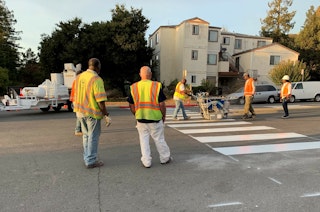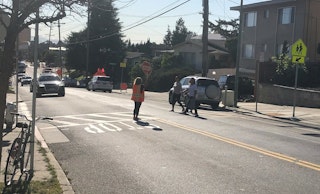The OakDOT Traffic Safety Request Program works to deliver quick-build and low-cost improvements—typically using traffic signs, pavement markings, and small-scale traffic calming devices—to improve traffic safety by reducing traffic speeds and calming driving behavior. These improvements are focused on specific intersections and street segments.
Traffic Safety Requests
Learn about the OakDOT Traffic Safety Request Program
About

How to Submit a Request
Please go to the City’s OAK 311 webpage to learn about the different ways you can submit a request.
One of the most commonly-used services to address Oaklanders’ traffic safety concerns is the Traffic Safety Request Program managed by the OakDOT Safe Streets Division. We evaluate every traffic safety request from the community and provide a written response explaining whether and why we will proceed with taking further engineering action. Our decision-making is based on a data-driven prioritization model which is described in detail below. We receive, on average, more than 800 service requests each year from our residents, merchants, schools, advocacy groups, construction contractors, other City departments, and peer transportation agencies.
How We Prioritize Requests

Because we have more requests and needs than we have resources to implement traffic safety improvements, we have to make decisions about which requests to prioritize. To make those decisions, we evaluate and score each request so that we can prioritize the highest-scoring requests for an equitable allocation of resources.
Our prioritization approach is consistent with Oakland’s Safe Oakland Streets initiative goals to address severe and fatal crashes and historic injury inequities – and was developed to prioritize locations where more severe crashes are concentrated, in neighborhoods where more vulnerable residents live, and near places where more vulnerable populations travel.
The three factors we use in our prioritization model are:
- Traffic Collisions: We prioritize requests in areas with the highest rates of traffic collisions with a focus on collisions that result in severe injuries and fatalities.
- Neighborhood Equity: We prioritize work in neighborhoods with higher concentrations of low income residents, communities of color, seniors, and people with disabilities. To review the data we’re using, please see OakDOT’s Geographic Equity Toolbox.
- Adjacent Land Use/Activities: We prioritize locations adjacent to places where vulnerable populations travel, such as schools, libraries, senior centers, health clinics, major transit stops, etc. See this link for a comprehensive list of the land uses and parcels referenced.
The above three factors are weighted equally—1/3 each—for the total service request score. The interactive map at this link summarizes the service request scores for every street segment in Oakland. Clicking on a specific street segment will display the score of the segment consisting of the associated collision, equity, and adjacent land use/activities factors. The Safe Streets Division keeps a running list of all the traffic safety requests received within the previous 365 days and selects, for further investigation, the requests that score the highest. In summer 2021 we amended the scoring by updating the crash and equity data and fine-tuning the adjacent land use/activities parameters. A detailed description of this update and the data sources is available in this report and accompanying appendix.
School-initiated Traffic Safety Requests

School-initiated traffic safety requests are processed differently. When a school in Oakland contacts our office to request traffic safety improvements, we assign it to staff and resources that are committed to school area traffic safety work. We put school-generated requests in a separate work flow to ensure that schools uniformly receive priority consideration. Learn more about OakDOT’s comprehensive approach to school traffic safety.
Speed Bump Program
The Speed Bump Program is primarily resident-driven, requiring support from two-thirds of the addresses on the block in request. This is different from the Traffic Safety Request Program mentioned above, which uses a data-driven prioritization process. Residents may apply for a speed bump any time by filling out an application found here on our website: https://www.oaklandca.gov/services/apply-for-a-speed-bump. Every speed bump request is evaluated by Safe Streets with input from the Fire Department and AC Transit for their operational needs such as vehicle size and travel/response time.
Larger Capital Projects/Traffic Safety Improvements
While our service request and speed bump programs are critical and popular platforms for the public to engage OakDOT regarding their traffic safety concerns, many requests we receive cannot be adequately addressed by quick-build and low-cost solutions that are mostly confined to specific intersections and street segments using traffic signs, pavement markings, and small-scale traffic calming devices.
Solutions that require larger scale planning, funding, and engineering – for example, projects that span an entire neighborhood or corridor, or projects that require extensive electrical, concrete, or landscaping work – are referred to separate OakDOT teams or processes like the City’s two-year Capital Improvement Program or an external transportation grant to receive proper scoping and resourcing to achieve the best possible results.